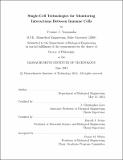Single-cell technologies for monitoring interactions between immune cells
Author(s)
Yamanaka, Yvonne J. (Yvonne Joy)
DownloadFull printable version (11.47Mb)
Other Contributors
Massachusetts Institute of Technology. Department of Biological Engineering.
Advisor
J. Christopher Love and Darrell J. Irvine.
Terms of use
Metadata
Show full item recordAbstract
Immune cells participate in dynamic cellular interactions that play a critical role in the defense against pathogens and the destruction of malignant cells. The vast heterogeneity of immune cells motivates the study of these interactions at the single-cell level. In this thesis, we present new tools to characterize how individual immune cells interact with each other and with diseased cells. We develop a nanowell-based platform to investigate how natural killer (NK) cells interrogate and attack diseased target cells. This platform enables integrated analysis of cytolytic activity, secretory activity, receptor expression, and dynamic parameters of interactions between thousands of individual NK cells and target cells. Using this platform, we show that NK cells operate independently when lysing a single target and that motility during contact is associated with the secretion of certain cytokines. Extending the platform, we investigate how contact with a target induces the shedding of CD16 from the surface of an NK cell. NK cells use CD16 to recognize antibody-coated target cells, and thus the loss of CD16 is of clinical interest. We show that the loss of CD16 is correlated to the length of time that the NK cell spends in contact with a target but that not all NK cells that shed CD16 exert common effector functions. In wells with multiple NK cells, shedding occurs in a more coordinated manner than would be expected by chance alone. Next, we compare the functional properties of NK cells with distinct repertoires of inhibitory receptors. Inhibitory receptors prevent NK cells from attacking healthy cells, and their expression can confer NK cells with increased functional activity in a process known as "licensing". We show that despite forming prolonged contacts with target cells, unlicensed NK cells are less likely than licensed NK cells to secrete cytokines. Finally, we present tools to study other modes of interaction between immune cells. Towards this end, we develop and apply fluorescent cellular barcoding strategies to efficiently analyze the secretory properties of individual immune cells from different populations. Altogether, this thesis contributes new tools for single-cell analysis and applies them to reveal new insights about intercellular interactions.
Description
Thesis: Ph. D., Massachusetts Institute of Technology, Department of Biological Engineering, 2014. This electronic version was submitted by the student author. The certified thesis is available in the Institute Archives and Special Collections. Cataloged from student-submitted PDF version of thesis. Includes bibliographical references (pages 175-194).
Date issued
2014Department
Massachusetts Institute of Technology. Department of Biological EngineeringPublisher
Massachusetts Institute of Technology
Keywords
Biological Engineering.